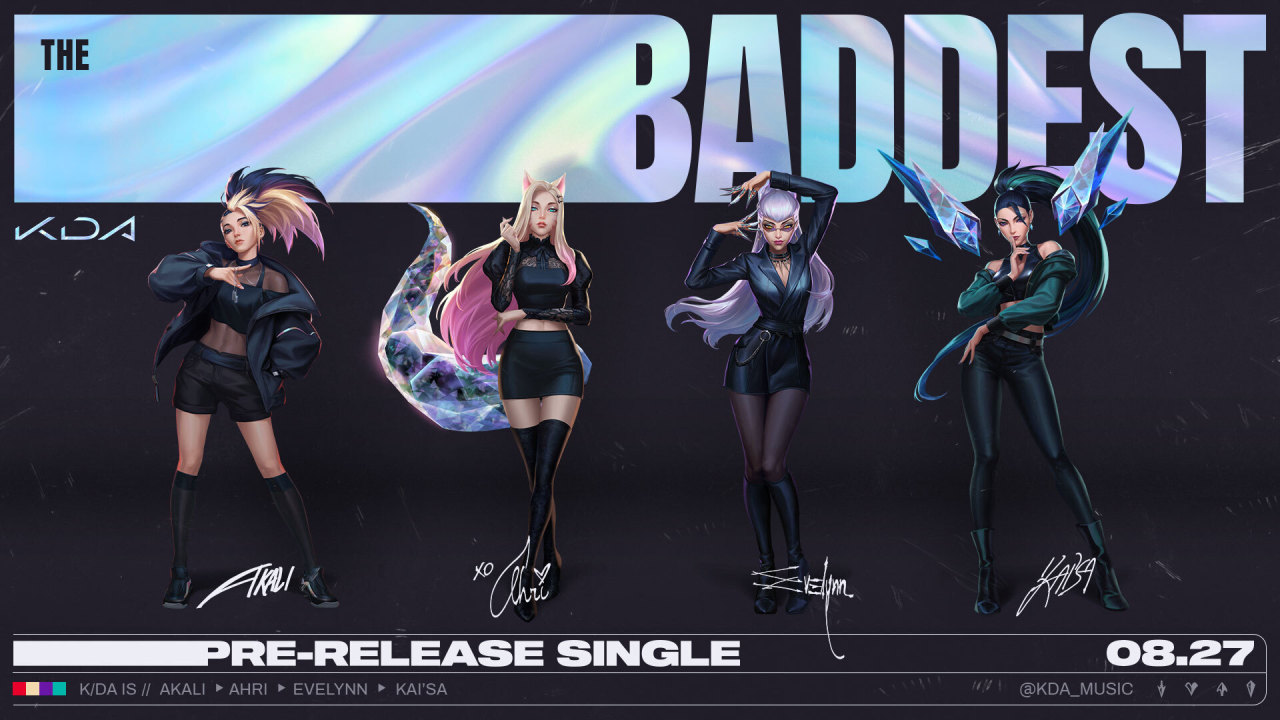Era of virtual artist: Riot Games’ virtual K-pop group K/DA returns
By Lim Jang-wonPublished : Sept. 1, 2020 - 12:41

Virtual K-pop group K/DA released the group’s new single, “The Baddest,” on Aug. 28, with the first EP to be released later this year.
K/DA debuted at the opening of the 2018 League of Legends World Championship finals in Incheon, when four artists performed with their characters through hologram representations. K/DA consists of four female LoL characters -- Ahri, Kai’Sa, Evelynn and Akali -- who are each voiced by different artists. The group name derives from a statistic used in LoL, referring to kills, deaths and assists.
K-pop group (G)-Idle’s Soyeon and Miyeon, who participated as Akali and Ahri in 2018, have returned once again as their characters, while Bea Miller and Wolftyla join the group.
“Ever since K/DA premiered their explosive track POP/STARS at the 2018 League of Legends World Championships, fans always ask what’s next for the group,” said Toa Dunn, head of Riot Games Music on Aug. 28.
K/DA’s 2018 debut single reached No. 1 on the iTunes K-pop chart and for Billboard’s World Digital Song Sales. The music video of the debut single, which has over 360 million views on YouTube, is considered one of the most successful K-pop group debuts to date on the platform.
K/DA’s new song is currently in the top 10 of the iTunes K-pop chart, behind BTS and Blackpink, attesting to their popularity as a major K-pop group.
While the idea of a virtual artist might be new to some people, it has been around for more than two decades.
The first ever virtual artist was Japan’s Kyoko Date, who debuted in 1996. In Korea, cybersingers such as Adam, CYDA and Lusia also gained popularity when they debuted in 1998. The first generation of virtual singers were abandoned, however, as the costs of production exceeded revenue, rendering them unprofitable.
Nearly two decades later, with the technological strides that have been made some virtual idols like K/DA rival the popularity of top artists around the world.
Virtual singers can be divided into two major categories: characters voiced by actual singers and vocaloids.
While characters of K/DA have artists singing each characters’ parts, vocaloids like Hatsune Miku have a digital program that sings the lyrics based on a sample voice.
Japan‘s Hatsune Miku is one of the most popular virtual idols in the world. Crypton Future Media debuted the original vocaloid that uses the voice of actress Saki Fujita in 2007. Since then, Hatsune Miku has been featured in over 100,000 songs worldwide, reaching unprecedented popularity for a virtual idol.
The android diva was invited to perform at 2020 Coachella, before the festival was postponed due to COVID-19. Her voice also appeared in a promotional video for the Tokyo Olympics.
Many music charts and musicians are keeping an eye on virtual singers like Hatsune Miku and K/DA as their global popularity soars, as some already consider them to be mainstream.
By Lim Jang-won (ljw@heraldcorp.com)
-
Articles by Lim Jang-won








![[Kim Seong-kon] Democracy and the future of South Korea](http://res.heraldm.com/phpwas/restmb_idxmake.php?idx=644&simg=/content/image/2024/04/16/20240416050802_0.jpg&u=)








![[KH Explains] Hyundai's full hybrid edge to pay off amid slow transition to pure EVs](http://res.heraldm.com/phpwas/restmb_idxmake.php?idx=652&simg=/content/image/2024/04/18/20240418050645_0.jpg&u=20240418181020)

![[Today’s K-pop] Zico drops snippet of collaboration with Jennie](http://res.heraldm.com/phpwas/restmb_idxmake.php?idx=642&simg=/content/image/2024/04/18/20240418050702_0.jpg&u=)